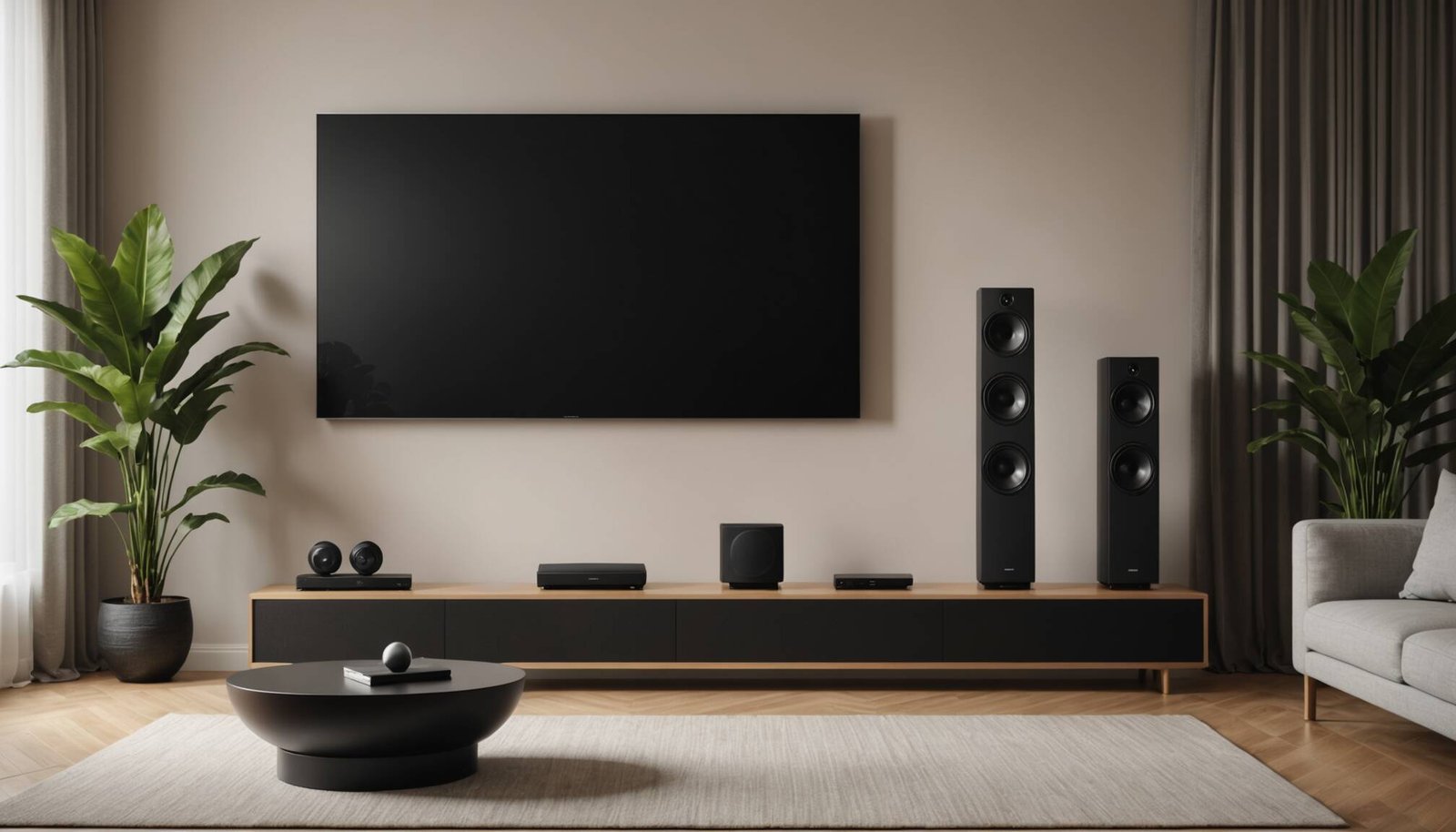10 best active speakers for your home audio setup (2025)
Understanding active vs passive speakers: key differences explained
When setting up a home audio system, one of the first decisions you’ll need to make is choosing between active and passive speakers. While both types can deliver excellent sound quality, they differ significantly in their design, functionality, and ease of use.
What are active speakers?
Active speakers have built-in amplifiers specifically designed to match their drivers, creating an integrated audio solution. This design approach offers several advantages, including simplified setup, optimized performance, and reduced cable clutter. According to audio experts, the integrated amplification ensures consistent sound quality and better control over audio reproduction.
Key advantages of active speakers
- Built-in amplification eliminates the need for external amplifiers
- Optimized sound quality through matched components
- Simplified setup with fewer cables and connections
- Often include advanced features like DSP and multiple input options
- Space-saving design ideal for smaller rooms
Understanding passive speakers
Passive speakers require external amplification and offer more flexibility in terms of system customization. While they need more components and setup expertise, they provide greater freedom to mix and match equipment according to personal preferences. Research shows that passive speakers can deliver exceptional sound quality when properly matched with high-quality amplifiers.
Sound quality comparison
- Active speakers deliver consistent, optimized sound straight out of the box
- Passive speakers allow for more sound customization through amplifier pairing
- Both types can achieve excellent audio quality when properly configured
- Active speakers often include built-in DSP for room correction
Connectivity and modern features
Modern active speakers have embraced digital connectivity, with many models offering wireless streaming options. According to What Hi-Fi?, premium active speakers now include features like Wi-Fi, Bluetooth aptX HD, and support for high-resolution audio formats, making them increasingly versatile for modern audio setups.
Cost considerations
- Active speakers typically have a higher upfront cost but include amplification
- Passive speakers require separate amplifier purchase and setup
- Long-term upgrade potential is greater with passive speakers
- Active speakers often provide better value for those seeking an all-in-one solution
Understanding these fundamental differences between active and passive speakers will help you make an informed decision based on your specific needs, budget, and technical expertise. The choice ultimately depends on factors such as room size, desired features, and whether you prefer a simplified setup or more customization options.
Top active speakers under £500
Looking for quality active speakers without breaking the bank? Here’s our selection of the best budget-friendly options available in the UK market for 2025.
Q Acoustics M20 HD Wireless Music System – £399
The Q Acoustics M20 HD stands out as one of the best value propositions in the sub-£500 category. These versatile speakers feature a 5″ mid/bass driver and 22mm decoupled tweeter, delivering impressive sound quality powered by a 65W digital amplifier. The system includes modern connectivity options like Bluetooth 5.0 with aptX HD, making it perfect for high-resolution streaming.
Edifier R1280DB – £129.99
The Edifier R1280DB offers exceptional value for money, making it an excellent choice for those on a tighter budget. With 42W of power output and a built-in digital-to-analog converter, these speakers deliver surprisingly robust sound quality. The side-mounted controls for input selection, volume, bass, and treble make adjustments convenient, while multiple connection options ensure versatility.
Edifier R1700BT – £149.99
For those seeking a slight step up from the R1280DB, the R1700BT presents an attractive option with its 15W RMS per channel output and classic wood finish. The speakers feature a 4-inch bass driver paired with a 13mm silk dome tweeter, housed in an acoustically optimized wooden enclosure that helps deliver natural sound with impressive bass presence.
Klipsch KD-400 – £299
The Klipsch KD-400 powered bookshelf speakers showcase impressive performance with their 4″ IMG mid/bass driver and 25mm Dhorm tweeter. With a total system power of 48W (96W Peak), these speakers deliver dynamic sound that works well for both music and movies. The inclusion of Bluetooth, RCA, and digital optical inputs, plus a subwoofer output, makes them highly versatile for various setups.
When selecting speakers in this price range, it’s important to consider your specific needs and usage scenarios. For instance, if streaming is your primary source of music, the Q Acoustics M20 HD might be worth the extra investment for its superior wireless capabilities. However, if you’re looking for pure value for money, the Edifier R1280DB delivers remarkable performance at its price point.
- Best overall value: Q Acoustics M20 HD
- Best budget choice: Edifier R1280DB
- Best for classic styling: Edifier R1700BT
- Best for versatility: Klipsch KD-400
For more detailed specifications and the latest prices, you can check out comprehensive reviews on AV.com or K&B Audio.
Premium active speakers reviews
For audiophiles and music enthusiasts seeking the ultimate sound experience, premium active speakers offer exceptional audio quality, advanced features, and superior build quality. Let’s explore some of the top high-end options available in 2025.
KEF LS50 Wireless II
Leading the premium segment, the KEF LS50 Wireless II represents the pinnacle of active speaker technology. These speakers feature KEF’s advanced 12th generation Uni-Q driver array with a 5.25″ mid/bass driver and 25mm MAT tweeter. The bi-amplification system delivers 100W for the tweeters and 280W for the mid/bass drivers, ensuring powerful and precise sound reproduction.
- Exceptional connectivity including Wi-Fi, Bluetooth 4.2, AirPlay 2, and Chromecast
- Metamaterial Absorption Technology (MAT) for reduced distortion
- Comprehensive app control via KEF Connect
- Price: Around £2,000
Acoustic Energy AE1 Active
The Acoustic Energy AE1 Active represents British engineering at its finest. These speakers feature dedicated 50-watt class A/B power amplifier modules for each drive unit, delivering exceptional clarity and control across the frequency range. While they may lack modern wireless connectivity, they excel in pure audio performance.
- Professional-grade balanced XLR inputs
- Precise bass and treble adjustment controls
- Outstanding mid-range performance
- Price: £800-£1,000
KEF LSX II
As a more compact alternative to the LS50 Wireless II, the KEF LSX II delivers remarkable performance in a smaller package. These speakers incorporate an 11th generation Uni-Q driver array with 4.5″ magnesium/aluminium drivers and 19mm tweeter, powered by sophisticated Class D amplification (according to What Hi-Fi?).
- Supports high-resolution audio formats including DSD and MQA
- Comprehensive streaming capabilities
- Compact form factor ideal for smaller spaces
- Price: Around £1,000
Kanto TUK
The Kanto TUK stands out in the premium segment with its versatility and comprehensive feature set. These speakers include a built-in phono preamp for turntable connectivity, making them perfect for vinyl enthusiasts (as noted by AV.com).
- High-quality AMT tweeter for detailed highs
- Built-in headphone amplifier
- Dedicated subwoofer output
- Price: £749.99
Each of these premium active speakers offers unique advantages for different listening preferences and environments. The KEF models excel in pure audio performance and modern connectivity, while the Acoustic Energy AE1 Active focuses on traditional audio excellence. The Kanto TUK provides exceptional versatility with its comprehensive feature set, making it an excellent all-rounder in the premium segment.
Wireless connectivity options for active speakers
Modern active speakers come equipped with various wireless connectivity options, making them more versatile and user-friendly than ever before. Understanding these different connection methods can help you choose the right speakers for your needs.
Bluetooth connectivity
Most active speakers today feature Bluetooth connectivity, with many supporting advanced codecs like aptX HD and AAC. For example, the KEF LSX II comes with Bluetooth 5.0, offering improved range and stability compared to older versions. The key benefits of Bluetooth include:
- Quick and easy pairing with mobile devices
- Wide compatibility with smartphones, tablets, and computers
- No network setup required
- Decent sound quality for casual listening
Wi-Fi and network streaming
Premium active speakers often include Wi-Fi connectivity, which provides several advantages over Bluetooth. The KEF LS50 Wireless II, for instance, offers comprehensive network streaming capabilities including:
- AirPlay 2 support for Apple devices
- Google Chromecast built-in
- Native support for streaming services
- High-resolution audio streaming
- Multi-room audio capabilities
Advanced streaming platforms
Many modern active speakers now integrate directly with streaming services and platforms. The Q Acoustics M20 HD system, for example, provides seamless access to popular streaming services while maintaining high audio quality through its digital signal processing.
- Direct Spotify Connect integration
- DLNA compatibility for network streaming
- Internet radio support
- Multi-room synchronization
Connection stability and quality
The quality and stability of wireless connections can significantly impact your listening experience. Higher-end active speakers like the Edifier S1000W often incorporate advanced features to ensure reliable wireless performance:
- Dual-band Wi-Fi support (2.4GHz and 5GHz)
- Advanced antenna design for better reception
- Automatic frequency selection
- Buffer management for uninterrupted playback
When choosing active speakers with wireless capabilities, consider your primary use case and the devices you’ll be connecting to ensure compatibility with your existing equipment and preferred streaming services.
How to choose active speakers: A comprehensive buying guide
Selecting the right active speakers requires careful consideration of several key factors. This guide will help you navigate the essential aspects to consider when making your purchase decision.
Understanding your budget
Active speakers come in various price ranges, each offering different features and performance levels:
- Entry-level (£100-£300): Ideal for casual listening and computer setups
- Mid-range (£300-£600): Better sound quality and additional features
- Premium (£600+): Audiophile-grade sound and advanced connectivity options
Room size and speaker placement
The size of your listening space significantly impacts speaker choice. Larger rooms typically require speakers with higher power output and better bass response. Consider the following placement factors:
- Distance from walls (minimum 20cm recommended)
- Speaker height relative to listening position
- Room acoustics and treatment
- Available space for speaker stands or shelves
Connectivity requirements
Modern active speakers offer various connection options to suit different needs. According to AV.com’s comprehensive guide, essential connectivity features include:
- Bluetooth with aptX HD support for high-quality wireless streaming
- Wi-Fi capability for network streaming
- Digital inputs (optical, coaxial)
- Analog inputs (RCA, XLR)
- USB connectivity for computer audio
Power output and amplification
Power requirements vary based on room size and listening preferences. Consider these aspects:
- RMS power rating for continuous playback
- Peak power handling capability
- Amplifier class (Class D for efficiency, Class A/B for sound quality)
- Bi-amplification features
Build quality and durability
According to What Hi-Fi?’s expert analysis, build quality significantly impacts sound performance and longevity. Key considerations include:
- Cabinet material and construction
- Driver quality and materials
- Heat management systems
- Control interface durability
Additional features to consider
Modern active speakers often include extra features that can enhance functionality. The latest market analysis suggests looking for:
- Room correction technology
- Mobile app control
- Multi-room audio capability
- Voice assistant integration
- Firmware update support
Brand reputation and support
Consider these aspects when evaluating speaker brands:
- Length of warranty coverage
- Availability of local service centers
- Customer support quality
- Track record for reliability
- Firmware update frequency
Energy efficiency
Modern active speakers should balance performance with power consumption:
- Standby power consumption
- Auto-power off features
- Energy efficiency ratings
- Heat generation during operation
By carefully considering these factors, you can select active speakers that best match your needs, budget, and listening environment. Remember to prioritize the features that matter most to your specific use case while ensuring the speakers provide good value for money.

